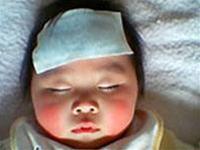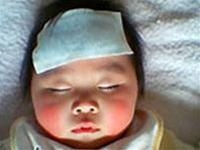Viral fever currently has no specific treatment, so the best approach is to reduce fever, apply cool compresses, and replenish fluids and electrolytes. If there is no bacterial superinfection, antibiotics should not be used.
 |
(Photo: TTO) |
Children’s immune systems are not yet fully developed, making them highly susceptible to infections. During this summer, the increase in the number of children hospitalized due to viral fever is a common occurrence in pediatric departments.
Under normal conditions, there are viruses that reside in the respiratory and digestive tracts. When conditions are favorable, they multiply, invade the body, and cause illness. Common viruses that cause fever include myxovirus, coxsackievirus, enterovirus, measles, chickenpox, and Japanese encephalitis. These viruses can spread from person to person, especially through respiratory and digestive pathways, potentially leading to outbreaks. One of the prominent symptoms of viral infection is a high fever, medically referred to as viral fever.
Characteristics of Fever Due to Viral Infection
High Fever: This is a common manifestation in cases of viral fever, typically ranging from 38 to 39 degrees Celsius, and can even reach 40-41 degrees Celsius. During a fever, children often feel fatigued and may not respond well to common antipyretics like paracetamol. Once the fever is reduced, they become alert and play normally.
Body Aches: Older children may experience muscle pain, expressing discomfort all over their bodies, while younger children may cry or be irritable.
Headache: Some children may have headaches but remain alert and not overly stimulated or restless.
Respiratory Inflammation: Symptoms of respiratory inflammation include cough, runny nose, sneezing, and a red throat.
Digestive Disorders: These may appear early if the fever is caused by a gastrointestinal virus or may occur a few days after fever onset, characterized by loose stools without blood or mucus.
Lymphadenopathy: Lymph nodes in the head, face, and neck may swell and be painful, visible or palpable.
Rash: This usually appears 2-3 days after the fever, and its emergence is often followed by a reduction in fever.
Conjunctivitis: The conjunctiva may be red, with discharge and tearing.
Vomiting: Children may vomit multiple times, usually occurring after eating.
There are no signs of bacterial infection.
These symptoms typically present dramatically and will gradually diminish and disappear within 3-5 days, with the child returning to health.
Management of Viral Fever in Children
Most viral illnesses currently have no specific medication, focusing primarily on symptomatic treatment, including viral fever in children. Therefore, commonly adopted measures include:
Fever Reduction: Typically, paracetamol is administered at a dose of 10 mg/kg every 6 hours.
Cool Compresses: Wipe the child’s body with a cool cloth, dry off sweat, have the child rest in a cool area, and dress them in light clothing.
Seizure Prevention: If the child has a high fever above 38.5 degrees Celsius, fever-reducing medication should be combined with antiepileptic drugs as prescribed by a doctor, especially for children with a history of seizures during high fevers.
Rehydration and Electrolytes: High fevers can lead to dehydration and electrolyte imbalances in the body, so it is important to use medications that help replenish lost fluids and electrolytes due to fever, such as oral rehydration solutions and diluted salty porridge.
Preventing Superinfection: Maintain cleanliness for the child, use 0.9% saline for eye and nasal care to prevent respiratory bacterial superinfection.
Nutrition: Provide easily digestible, nutritious liquid foods.
Hygiene: Clean the child’s body thoroughly and bathe them with warm water in a closed room.
It is crucial to take the child to a medical center immediately if they exhibit the following signs: a high fever above 38.5 degrees Celsius, especially over 39 degrees Celsius with antipyretics not providing relief; lethargy, excessive sleepiness, the occurrence of seizures, persistent and increasing headaches; nausea, frequent vomiting, and a fever lasting more than 5 days.
Viral fever can easily lead to outbreaks, so when a child is infected, it is necessary to isolate them and keep them warm. When a child is ill, they should not be sent to school. There are vaccines available for certain viral diseases such as Japanese encephalitis, measles, mumps, and rubella…




















































